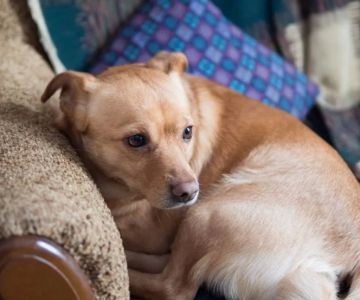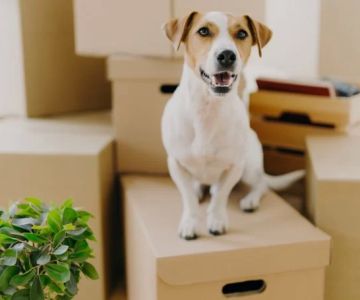Understanding Anxiety in Dogs
Just like humans, dogs can experience anxiety — and it’s more common than most pet owners realize. Whether it’s triggered by loud noises, separation, or unfamiliar environments, anxiety in dogs can affect their behavior, health, and overall quality of life. Recognizing the early warning signs is key to helping your furry friend stay calm and confident.
Dogs express stress differently than people do. While some might bark or pace, others withdraw or act destructively. These behaviors aren’t disobedience — they’re often cries for help. Understanding your dog’s anxiety is the first step toward managing it effectively and compassionately.
1. Excessive Barking or Whining
Emotional Distress Through Vocalization
If your dog barks, howls, or whines excessively — especially when you’re not home — it could be a sign of anxiety. This behavior often indicates emotional distress, a desire for comfort, or fear of being left alone. Unlike normal barking in response to noises or strangers, anxious barking tends to be persistent and seemingly without reason.

70060 County Road, 70060 Phoenix St #388, South Haven, MI 49090, USA
See DetailsReal Example
A golden retriever named Daisy began howling every time her owner left for work. After a consultation at Hidden Brook Veterinary, it was determined that Daisy was suffering from separation anxiety. With gradual desensitization training and calming supplements, her behavior improved significantly within weeks.
2. Destructive Behavior When Alone
Chewing, Digging, or Scratching
Does your dog destroy furniture or chew through shoes when left unsupervised? Destructive behavior is one of the most common signs of canine anxiety. It’s your dog’s way of coping with stress or boredom, often triggered by loneliness or confinement. Some dogs focus their destruction near doors or windows, as if trying to escape to find their owners.
How to Help
Providing mental stimulation through puzzle toys or leaving on soft background music can ease anxiety. Structured exercise and consistent routines also reduce excess energy that fuels destructive tendencies.
3. Pacing and Restlessness
Repetitive Motion as a Sign of Stress
Dogs that continuously pace or circle without purpose may be expressing nervous tension. Restlessness often occurs when they anticipate something stressful, such as storms, car rides, or your departure. Some anxious dogs may also pant or drool excessively during these moments, even if they’re not hot or thirsty.
Why It Happens
Just as humans fidget when anxious, dogs pace as a self-soothing mechanism. Keeping a calm environment and using positive reinforcement during stressful events can help your dog feel safer and more in control.
4. Trembling, Panting, or Shaking
Physical Signs of Fear and Anxiety
Shaking isn’t always caused by cold weather — sometimes it’s a physical manifestation of fear. Trembling, heavy panting, and pinned-back ears can all indicate anxiety. Many dogs display these behaviors during thunderstorms, fireworks, or vet visits. If you notice trembling without a clear external cause, it’s time to consider emotional stress as the culprit.
Veterinary Insight
According to veterinarians at Hidden Brook Veterinary, prolonged shaking or panting can also indicate medical issues like pain or metabolic imbalances. Always consult your vet to rule out physical causes before assuming it’s purely anxiety-related.
5. Changes in Eating or Sleeping Habits
Loss of Appetite or Insomnia
Anxiety can disrupt your dog’s normal routine in subtle but important ways. Some dogs lose their appetite when stressed, while others overeat for comfort. Similarly, you might notice them sleeping less or more than usual. These behavioral changes reflect hormonal and emotional imbalances caused by chronic stress.
What You Can Do
Establishing a predictable schedule and offering calm, low-stress feeding times can restore balance. Using slow feeders or interactive mealtime puzzles can also encourage relaxation and focus.
6. Excessive Licking or Self-Grooming
Comfort Through Repetition
Many anxious dogs lick themselves excessively, often focusing on one paw or spot. This repetitive action releases endorphins that temporarily soothe stress — similar to how humans might fidget or bite their nails. However, over time, it can cause skin irritation or hot spots that require veterinary care.
Behavioral Tip
To redirect this habit, offer your dog a frozen chew toy or soothing enrichment item. Keeping them mentally engaged reduces the need for compulsive self-soothing behaviors.
7. Unexpected Aggression or Withdrawal
Fear-Based Behavior
Some dogs show aggression — growling, snapping, or baring teeth — not out of dominance, but fear. Others retreat, avoiding touch or eye contact. Anxiety can make even the gentlest pets react defensively when they feel trapped or uncertain. Recognizing these reactions early prevents misunderstandings and helps your dog regain emotional balance.
Real Case Study
Riley, a rescue pit mix, became fearful of strangers after a traumatic experience at a dog park. With guidance from a behaviorist and gradual social exposure, his aggression diminished. His story highlights how patience and positive reinforcement can rebuild trust.
8. Accidents Indoors Despite House Training
Stress-Related Elimination
When a fully house-trained dog suddenly starts urinating or defecating indoors, it’s often a stress response rather than disobedience. Anxiety triggers hormonal changes that affect bladder control. This behavior may occur when pets are left alone too long, frightened by loud noises, or experiencing environmental changes like moving homes.
Professional Help
If accidents persist, a vet check-up is essential to rule out urinary or digestive issues. Once health concerns are excluded, anxiety-focused behavior training can help restore confidence and routine.
How to Support an Anxious Dog
1. Create Calm Through Routine and Environment
Dogs thrive on predictability. Feeding, walking, and bedtime should happen at consistent times. A quiet, comfortable space where your dog feels safe can make a world of difference during stressful situations like thunderstorms or fireworks.
2. Exercise and Mental Stimulation
Daily exercise helps reduce stress hormones and prevents restlessness. Combine physical activity with mental challenges such as scent games or training exercises. A tired, mentally stimulated dog is a calmer, happier one.
3. Professional Guidance
For persistent anxiety, consult your veterinarian. They can recommend behavior therapy, natural calming aids, or medication when appropriate. At Hidden Brook Veterinary, we specialize in anxiety management plans tailored to each pet’s personality and needs, ensuring your dog receives compassionate, effective care.
Helping Your Dog Feel Safe and Understood
Recognizing the signs of anxiety in your dog is an act of empathy. With the right combination of patience, structure, and professional guidance, you can transform anxious behaviors into confidence and trust. Every dog deserves to feel safe — and with consistent care, your companion will learn that the world, and your absence, aren’t things to fear but part of a secure, loving routine.
For personalized anxiety management strategies and professional behavioral support, visit Hidden Brook Veterinary — where understanding your pet’s emotions is the first step toward lifelong well-being.











